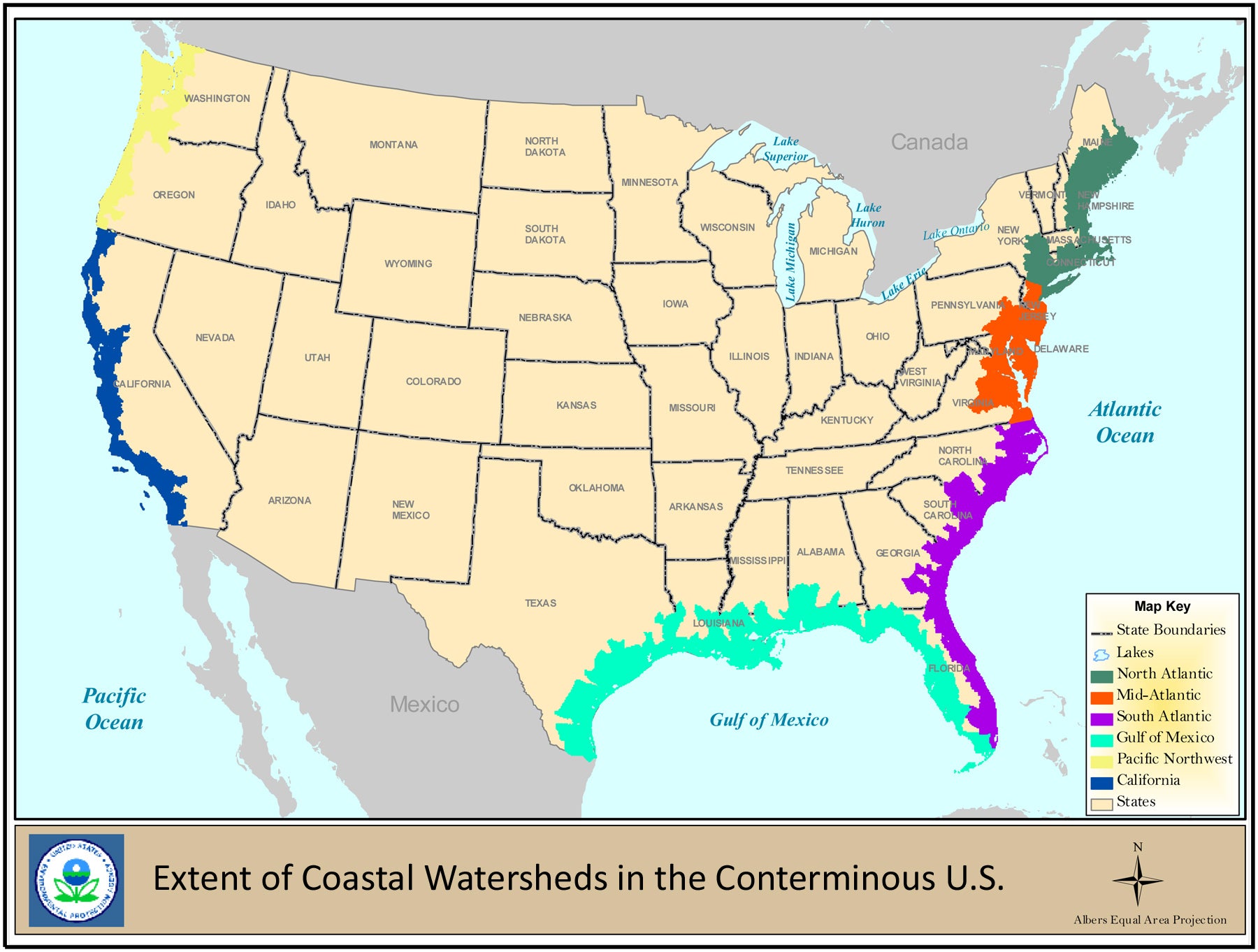What are coastal wetlands?
Coastal wetlands include saltwater and freshwater wetlands located within coastal watersheds — specifically USGS 8-digit hydrologic unit watersheds which drain into the Atlantic Ocean, Pacific Ocean, or Gulf of Mexico.
Wetland types found in coastal watersheds include salt marshes, bottomland hardwood swamps, fresh marshes, mangrove swamps, and shrubby depressions known in the southeast United States as “pocosins.” Coastal wetlands cover about 40 million acres and make up 38 percent of the total wetland acreage in the conterminous United States. 81 percent of coastal wetlands in the conterminous United States are located in the southeast.
The diagram below illustrates the range of wetlands which can be found in a coastal watershed. These wetlands can be tidal or non-tidal, and freshwater or saltwater.

As seen on the map (above), coastal watersheds can extend many miles inland from the coast. The extent and condition of wetlands within a coastal watershed is both dependent on and influences the health of the surrounding watershed. Wetlands in coastal watersheds are experiencing disproportionate losses compared to wetlands in the rest of the country, making them particularly important areas for protection.
Why are coastal wetlands important?
- Flood Protection: Coastal wetlands protect upland areas, including valuable residential and commercial property, from flooding due to sea level rise and storms.
- Erosion Control: Coastal wetlands can prevent coastline erosion due to their ability to absorb the energy created by ocean currents which would otherwise degrade a shoreline and associated development.
- Wildlife Food & Habitat: Coastal wetlands provide habitat for many federally threatened and endangered species, including Whooping Crane, Louisiana Black Bear and Florida Panther. Two of North America’s migratory bird flyways pass over the Pacific and Atlantic coasts, where coastal wetlands provide temporary habitat to waterfowl and shorebirds.
- Commercial Fisheries: Over 50 percent of commercial fish and shellfish species in the Southeastern United States rely on coastal wetlands.
- Water Quality: Wetlands filter chemicals and sediment out of water before it is discharged into the ocean.
- Recreation: Recreational opportunities in coastal wetlands include canoeing, kayaking, wildlife viewing and photography, recreational fishing and hunting.
- Carbon Sequestration: Certain coastal wetland ecosystems (such as salt marshes and mangroves) can sequester and store large amounts of carbon due to their rapid growth rates and slow decomposition rates.
What is the rate of coastal wetland loss?
In the coastal watersheds of the Atlantic, Pacific, the Gulf of Mexico and the Great Lakes, wetlands were lost at an average rate of about 80,000 acres per year between 2004 and 2009.
Coastal wetland acreage trends are documented in the Status and Trends of Wetlands in the Coastal Watersheds of the Conterminous United States report by the U.S. Fish & Wildlife Service (FWS) and the National Oceanic and Atmospheric Administration’s National Marine Fisheries Service. This analysis concluded that more than 80,000 acres of coastal wetlands are being lost on average each year, up from about 59,000 acres lost per year in the previous study covering 1998 to 2004. A majority of this loss occurred in freshwater wetlands.
Why are coastal wetlands being lost?
Coastal wetland losses occur as a result of both human activity and natural processes.
Human Activity: Human activities which may lead to losses of coastal wetlands include urban and rural development, agriculture, and silviculture. These land use changes can also indirectly impact nearby wetlands by altering hydrology through increased runoff or water withdrawals in the watershed. Most of this loss occurs in freshwater wetlands. Over half of the U.S. population lives in coastal counties, intensifying the stress on coastal wetlands relative to inland areas.
Natural Processes: Coastal wetlands, especially estuarine and marine wetlands, are naturally altered by high energy events such as erosion and inundation from sea level rise and storms. The impacts of these processes may be magnified by climate change and shoreline armoring. Estuarine wetlands typically protect the coastline from erosion and flooding, but if sea level increases and development prevents inland migration of wetlands, more wetlands will be converted to open water.
What can I do to protect coastal wetlands?
- Participate in programs that help protect and restore wetlands. Contact local, state, or federal agencies, community groups, environmental organizations and other non-government organizations.
- Report illegal actions such as unauthorized wetland fill or dredging activities to government authorities, such as the U.S. Environmental Protection Agency or the U.S. Army Corps of Engineers.
- Pick up litter and dispose in appropriate trash containers. Keep surface areas that wash into storm drains clean from pet waste, toxic chemicals, fertilizers and motor oil, which can eventually reach and impair our wetlands.
- Use native species when planting trees, shrubs and flowers to preserve the ecological balance of local wetlands.
- Use “living shoreline” techniques that make use of plant roots to stabilize soil if you own waterfront property and your shoreline or river bank needs to be stabilized.
- Avoid wetlands if you are expanding your house or installing a shed.
- Use phosphate-free laundry and dishwasher detergents. Phosphates encourage algae growth, which can suffocate aquatic life.
- Use paper and recycled products made from unbleached paper. Bleached paper contains toxic chemicals that can contaminate water.
- Use non-toxic products for household cleaning and lawn and garden care. Never spray lawn and garden chemicals outside on a windy day or on a day that it might rain and wash the chemicals into waterways.
- Enjoy the scenic and recreational opportunities coastal wetlands offer, while preserving their integrity for future generations by minimizing the use of heavy equipment and staying in designated visitor areas where available.